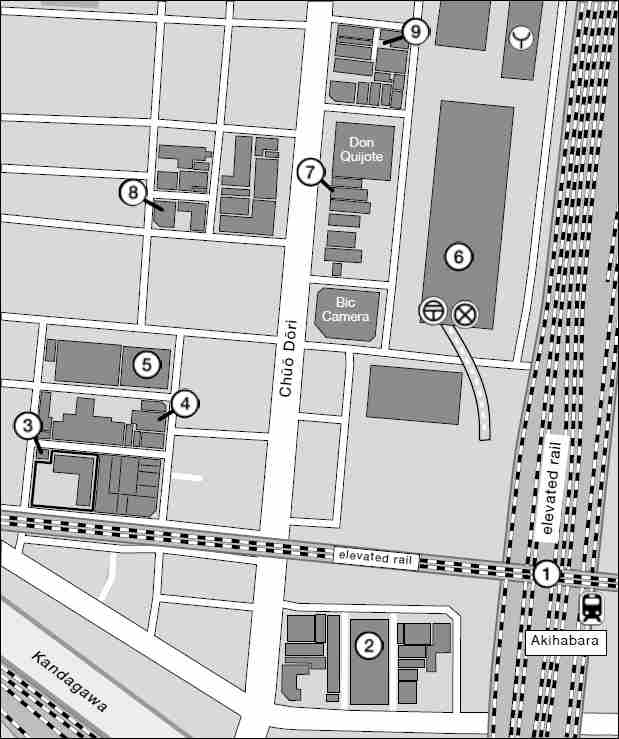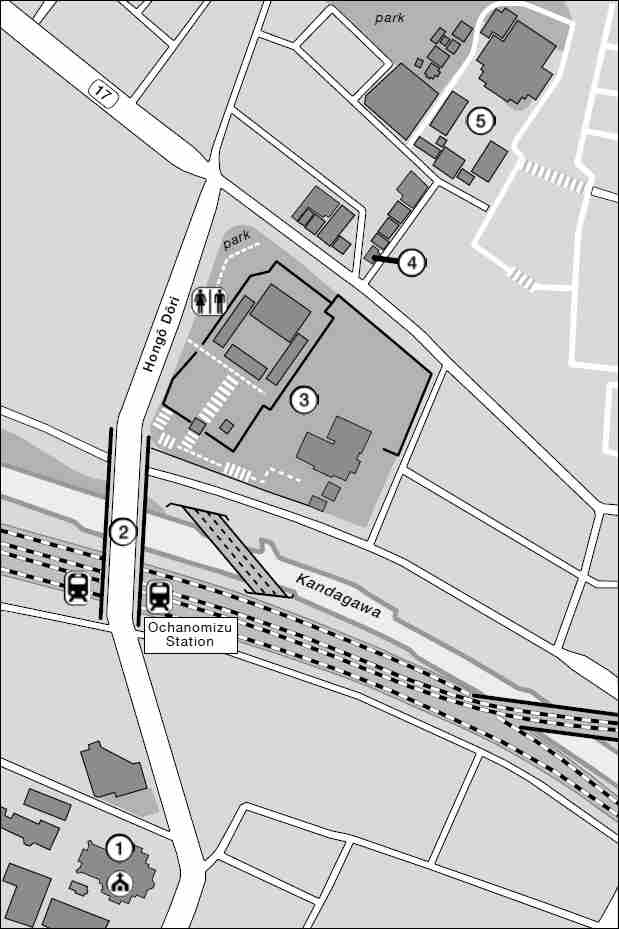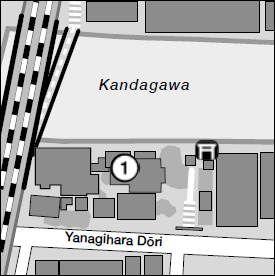秋葉原 • 神田
AKIHABARA AND KANDA
Akihabara
This area gets its name from Akibagahar “Akiba Field.” Once the location of Akiba Jinja “autumn leaf shrine,” it later became the site of a rail yard. Today Akihabara is famous for two things: electronics, and merchandise for fans of anime, manga, and video games. After World War II the area near the Yamanote line train tracks was a thriving black market, stretching from what is now Ameya Yokochō, next to Ueno Station, in the north to the JR Akihabara Station in the south. The illicit goods found there included food, which was heavily rationed at the time, alongside a legal market for electronic components. As rationing ended and the remaining illegal operations were shut down, the market started to specialize. Akihabara became a center for electronics, everything from complete appliances to small parts, and later came to include personal computers and video games, which in turn drew a clientele interested in anime and manga. Today the area contains a diverse mix of shops: Stores may occupy several floors of a tall building or be tucked away on side streets, or even in basements accessible only by walking through another store. The main street is Chūō Dōri, which can be so crowded, noisy, and bustling that you may want to escape due to sensory overload. Head to a side street or enter a shop and you will likely find a quieter environment. At night a profusion of commercial signs light up, making this area truly electric. Chūō Dōri is also closed to vehicles on Sundays to become a broad pedestrian promenade.
Kanda
This is an area spanning both sides of the Kandagawa, including much of Akihabara, and is a mix of the modern and the old. The old includes shrines, temples, and even an Eastern Orthodox cathedral, as well as buildings, scattered here and there, that survived both World War II and the predation of developers. While Akihabara has plenty of inexpensive eateries, this area has restaurants you may want to save your appetite for.
NOTE: Shops open, relocate, and go out of business at a faster pace in Akihabara than in many other parts of Tokyo, so do not be surprised if there are changes. In fact as I was writing this chapter, two shops moved to another building. I will attempt to track these changes in the online supplement to this book.
TIP: Akihabara is often the location of theme cafes focusing on a particular TV show or game. These are often temporary, so keep your eye out for what is open when you go.
DETAIL 1
There are actually three stations with this name in close proximity. For rail traffic there is the larger JR station for the Chūō Sōbu, Yamanote, and Tōhoku Main lines. For the subway there is the Tsukuba Express station just to the east of the JR station, and a Tokyo Metro Hibiya Line subway station two blocks to the east of that (and not shown on the map). Which one you exit will affect your initial navigation of the area.
 Akihabara Radio Kaikan 秋葉原ラジオ会館
Akihabara Radio Kaikan 秋葉原ラジオ会館
This collection of shops is housed in twelve stories if you count the two basements. The original Radio Kaikan was two stories and opened in 1950. An additional eight-story building was constructed in 1962 on an adjacent lot. In 1972 the original was demolished and another eight-story building was linked with the 1962 building to form a new complex. In 1976 NEC opened a shop here, igniting the microcomputer boom in Japan. Originally the shops mainly sold electronics, but with the growth of otaku culture the building tenants shifted to goods for fans of anime, manga, and PC games. After the 2011 Tōhoku earthquake, Radio Kaikan was closed for safety reasons and it was decided to demolish the building. The current building was built in 2014 and houses over thirty shops.
 http://www.akihabara-radiokaikan.co.jp
http://www.akihabara-radiokaikan.co.jp
AKIHABARA AND KANDA WEST

AKIHABARA AND KANDA EAST
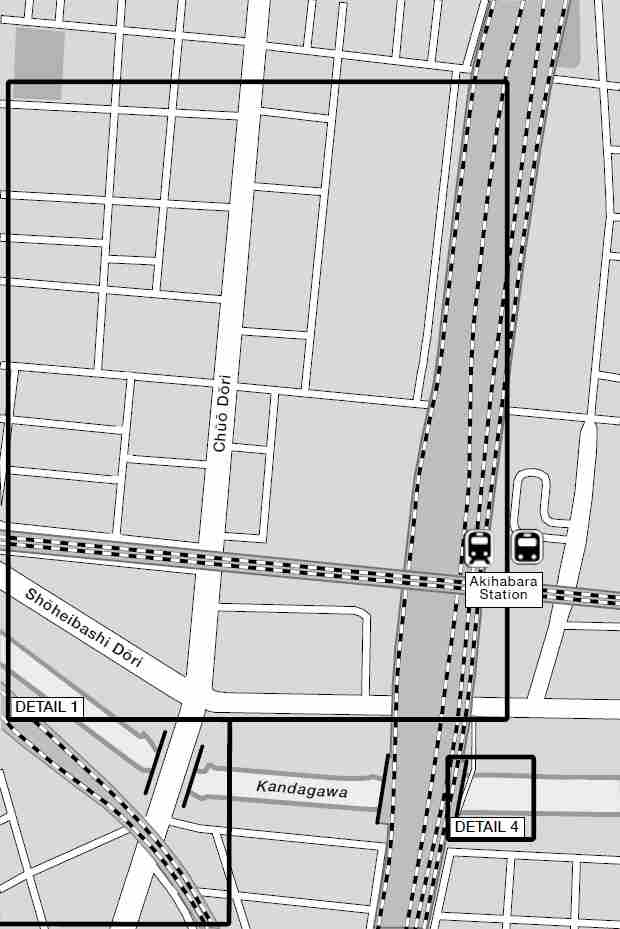
AKIHABARA DETAIL 1
There are two locations for this store established in 2003, one on the second floor of the Akihabara Radio Kaikan building  and the other on the fourth floor of the AKIBA Cultures ZONE
and the other on the fourth floor of the AKIBA Cultures ZONE  building. Both locations of this shop sell second-hand models, figurines, stuffed toys, and retro games, as well as goods related to anime, manga, and idol singers on consignment. A seller rents a numbered clear display case, and each item in the case is numbered and priced. Buyers find what they want, pick up a purchase card (available near the register), fill out the case and item numbers, then give it to staff who retrieve the desired items. The store then handles the transaction and pays the seller. One major advantage of this kind of shop is that you get to appraise the item in person rather than order online and be disappointed. The Japanese take very good care of their property and I’ve very rarely seen anything that looks worn in these cases. Often you can find hard-to-obtain items for very reasonable prices. Credit cards accepted for purchases over 3,000 yen.
building. Both locations of this shop sell second-hand models, figurines, stuffed toys, and retro games, as well as goods related to anime, manga, and idol singers on consignment. A seller rents a numbered clear display case, and each item in the case is numbered and priced. Buyers find what they want, pick up a purchase card (available near the register), fill out the case and item numbers, then give it to staff who retrieve the desired items. The store then handles the transaction and pays the seller. One major advantage of this kind of shop is that you get to appraise the item in person rather than order online and be disappointed. The Japanese take very good care of their property and I’ve very rarely seen anything that looks worn in these cases. Often you can find hard-to-obtain items for very reasonable prices. Credit cards accepted for purchases over 3,000 yen.
NOTE: Purchases are not refundable.
A small chain specializing in new and second-hand goods with a focus on anime, manga, video games, popular music, and related items. Many of their shops specialize in goods for women and girls, especially their stores in the Ikebukuro area. For this reason it is not surprising that the company has a majority of women on the staff and a large percentage of women managers. The first Akihabara store opened in 1996; it is presently located on the third floor of the Akihabara Radio Kaikan building, with several departments including a men’s store for ages eighteen and over only. The main store and over fifteen branches are located in Ikebukuro, all east of Ikebukuro Station, with most in the vicinity of the Sunshine 60 building.
Akihabara Shopping
Many location numbers for the Akihabara maps refer to the building a shop is in. For this reason a few shops have the same number. Shops with more than one location and number are cross referenced to the first entry for that shop. When in a shop, check for stairs and elevators—some shops are larger than they look and spread over several stories, or each floor could be a separate shop. If you plan to hunt for products related to anime, manga, and games, be aware that the focus in Akihabara is the latest and most popular shows. For older materials check second-hand shops like Mandarake and ASTOP or head to the Nakano Broadway Mall in Nakano. If there are specific items you want, bring a printout or screen capture on your smartphone to show staff. When asking about specific titles know the Japanese name and don’t assume your pronunciation will be understandable.
 Kaiyōdō Hobby Lobby Tokyo 海洋堂Hobby Lobby Tokyo
Kaiyōdō Hobby Lobby Tokyo 海洋堂Hobby Lobby Tokyo
Located in the Akihabara Radio Kaikan building, this is the Akihabara shop for the internationally famous figure manufacturer. Their figures range from hyper-realistic animals to fictional characters. The company’s products also include poseable replicas of Buddhist statues, military vehicles, buildings, historical personages, artworks, and pretty much anything else they think would have a market. They even partner with major museums and other institutions, such as the nearby Kanda Myōjin, to do small replicas of related objects.
An attractive Inari shrine dating from
1858 in the middle of a modern neighborhood of small shops and residences. The red fencing and torii stand out framing a corner plot filled with plants and a shrine. The building is elevated; a short flight of stairs leads to the front of the shrine. This is an excellent example of the little surprises one can find walking down an ordinary street in Tokyo.
 Kotobukiya Akihabara コトブキヤ 秋葉原館
Kotobukiya Akihabara コトブキヤ 秋葉原館
The Akihabara store for the famous toy, model, and figurine maker. The store is quite large: five stories including an event space. Products are grouped together by show or theme, and some items are unique to this one store. Among other highly popular series, they sell figures for Star Wars, DC Comic characters, Sailor Moon, Studio Gainax shows, and Studio Ghibli movies. They also have display cases, model making supplies, stationery, accessories, plushies, character themed snacks, pillow cases, and—oh, the heck with it—just lots of stuff.
 http://en.kotobukiya.co.jp/kotobukiya-akihabara-store-floor-guide/
http://en.kotobukiya.co.jp/kotobukiya-akihabara-store-floor-guide/
 Akiba-i / Akihabara Tourist Information Center 秋葉原観光情報センター
Akiba-i / Akihabara Tourist Information Center 秋葉原観光情報センター
I recommend going here early on your visit to Akihabara to obtain information. Located on the second floor of the Akihabara UDX building since 2010, this is a good place to pick up a very detailed map of the area in any of several languages, as well as have questions answered and get directions to specific shops. They have some English-speaking staff.
 https://www.akiba-information.jp/html/multi/multiple/index.html
https://www.akiba-information.jp/html/multi/multiple/index.html
Since the first store in Ikebukuro opened in 1983, Animate has been a major retailer of anime and manga related goods. Today there are something like 120 stores in Asia, although they do have a mail order business in the US. This particular store is one of the largest shops in the neighborhood. At the Akihabara branch there are seven floors plus a basement level with one of the floors reserved for special events. Find the floor you want on the directory or just take the elevator to the top floor and work your way down as you explore. Animate stocks anime, manga, dōjinshi, light novels, photo books, magazines, cards, games, CDs, art supplies, and especially character figures. In fact there are two floors devoted to character goods of all kinds, they even have unique items which are sold only at Animate stores.
Animate is more than retail, subsidiaries of the company include Animate Film and Libre Publishing.
 https://www.animate.co.jp/shop/akihabara/
https://www.animate.co.jp/shop/akihabara/
NOTE: A little of the stock is adult oriented as this shop caters to all ages.
This is the eight-story flagship store of the famous chain of second-hand shops for fans of anime, manga, and video games. This particular building was built to house the Akihabara branch and opened in 2008. As you approach the store you will see an entrance on the corner; while you can enter that way, it will put you right into the area where people bring items to sell to the store. It may be better to enter through the entrance on the side that places you at both the stairs and elevators. Unlike most shops in Akihabara, this one has many items from older anime and manga.
Shop carefully as there are no refunds or exchanges.
 https://mandarake.co.jp/dir/cmp/index-en.html
https://mandarake.co.jp/dir/cmp/index-en.html
A small Inari shrine completely surrounded by buildings and accessible only by going down a narrow alley and then another, narrower alley. Depending on which route is taken, larger folks may find themselves brushing the walls on both sides. The alley is dark and there are lights with sensors that will turn on as you walk toward the shrine, so don’t be startled. The shrine is on a very small but well-maintained plot of land, an example of what can be hidden away out of sight in Tokyo. Around 2014 a building next to this location was torn down, making the shrine visible from the street for a short time, pictured on various websites.
The alley leading directly to the shrine may be private property so be respectful and quiet.
NOTE: I was told of this shrine by popular culture scholar Patrick Galbraith many years ago. I could not find it on that trip but did find it a couple of years later.
DETAIL 2
This restaurant specializes in beef. All the beef is wagyu, which simply means any beef from Japan—and Japanese beef is very good beef. Established in 1949, it is housed in a ten-story building with specialties on three of the floors. In 2021, during the COVID pandemic, the company sold the building and is presently leasing space in it, and has scaled down the number of floors the restaurant uses.
As of the time of writing this the selection is:
Third floor: Western-style dishes. Nonsmoking on weekends and holidays.
Fourth floor: Western-style dishes. Nonsmoking.
Fifth floor: Korean-style BBQ.
 http://www.niku-mansei.com/foreign_language/index.html
http://www.niku-mansei.com/foreign_language/index.html
Over the centuries several bridges with different names have spanned the Kandagawa at this location. The bridge that opened in 1903 was to be called Yorozuyobashi, “Ten Thousand Generation Bridge,” however the kanji used for that name can also be pronounced Manseibashi and that pronunciation stuck with the local population. The pre-1903 bridge had been nicknamed the Meganebashi, “Eyeglasses Bridge,” due to it having two arches. The current bridge, built in 1930, is an attractive single-arch structure made of concrete. If you are there around sundown or after dark, look down toward the river and you may see some of the bats that nest in the area flying about.
This is the only Tokyo restaurant specializing in ankō (anglerfish, monkfish). The previous building was destroyed in the Great Kantō Earthquake and rebuilt in 1932. The lovely wooden structure sits on a corner near the Takemura sweetshop so you can actually photograph both of them in the same shot. Originally the restaurant was known as Iseshō (いせ庄) and opened near the Ginza in 1830. The second-generation owner moved the restaurant to its current location and re-named it Isegen. At first they served a variety of nabe dishes, until the fourth-generation owner decided to specialize in ankō. They still use a traditional method, considered the best, to cut the fish by hanging it from the jaw and slicing off the meat. Everything but the bones is used. There is also a seasonality to the menu as some dishes, such as eel, sweetfish, and loach, are only available in the summer. The building has been designated a historical landmark by the Tokyo government.
 http://www.isegen.com/English/
http://www.isegen.com/English/
 http://www.norenkai.net/en/portfolio-item/isegen/
http://www.norenkai.net/en/portfolio-item/isegen/
NOTE: Seating is traditional, on a cushioned tatami mats.
AKIHABARA DETAIL 2
This is a traditional sweetshop, a kanmidokoro (甘味処, “sweets place”), that is still operating in the original 1930 building. Takemura has a large menu but is best known for their awazenzai, a cake of steamed millet served with red bean paste, and agemanjū, a deep-fried bun filled with red bean paste that is served warm. Enjoy the sakurayu, a tea made with dried and lightly salted cherry blossoms. The only non-traditional item on their menu is ice cream, which was available in Japan when the restaurant first opened. Modern and traditional seating are available. Non-smoking.
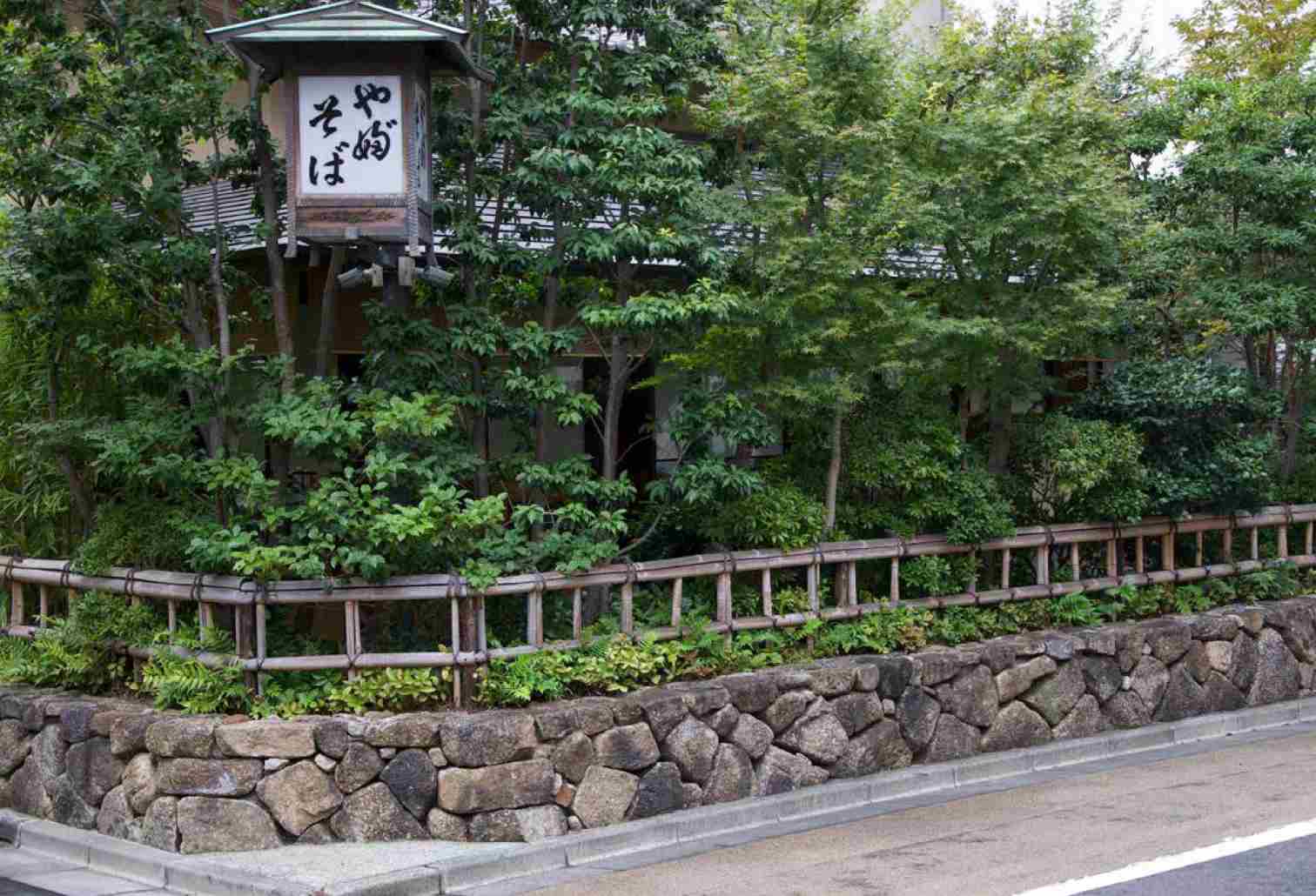
▲This lovely garden is found on the street side of Kanda Yabu Soba.
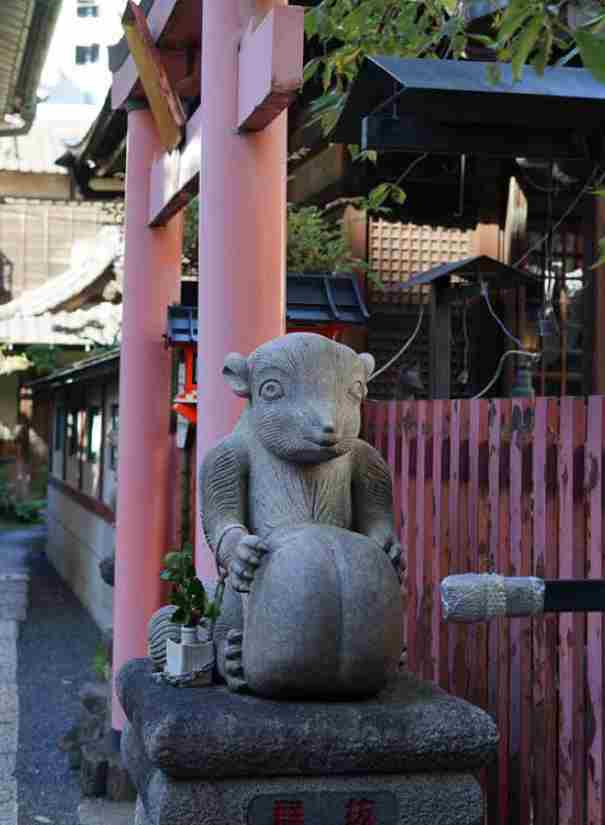
▲ A statue of a rather overly endowed male tanuki sits outside Yanagimori Jinja.
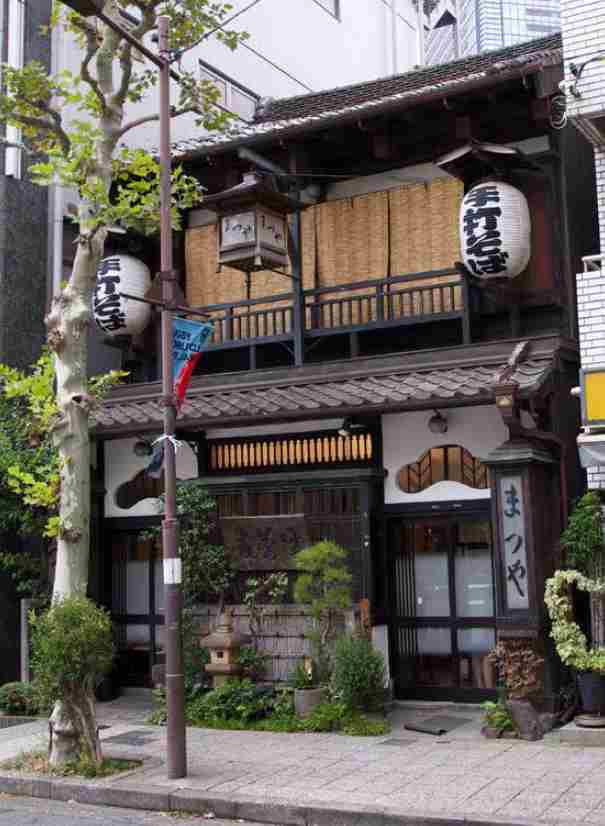
▲ Kanda Matsuya stands out as it is surrounded by contemporary structures.
Botan was established in the late 1890s. The present building dating from 1929 replaces one destroyed in the Great Kantō Earthquake. Their specialty is chicken sukiyaki. The staff prepares and brings you the ingredients for your order. You then do your own cooking at the table in a pot over a charcoal fire. The raw egg provided is for dipping your cooked meat in; you can leave it if you prefer. Expect to take your time—a sukiyaki meal here is in three parts followed by a light dessert. The staff does not speak English but will take your shoes at the entrance and show you a card with a description of the meal written in English. Credit cards are accepted.
A sobaya dating from 1884 with a relaxed and informal atmosphere. The current two-story building, constructed in 1925, has a narrow garden of plants between it and the sidewalk and is as old-fashioned as it sounds. This popular restaurant is busy at times, so it is not unusual to have to share a table with other customers. The menu is limited to variations on a few items. They serve both soba and udon, and the noodles are made by hand throughout the day so freshness is ensured. If you are not familiar with soba, order morisoba, which is just plain noodles, or zarusoba, which has a little shredded nori seaweed on top. Both are served cold and come with a dipping sauce and a small side dish of sliced onion that you can mix into the sauce. That square pot on the table is filled with sobayu: after you finish your soba, pour some into the remaining dipping sauce and sip it. Kanda Matsuya also has their own brand of various food items you can buy. Seating is Western style at tables.
The oldest operating sobaya in Tokyo, opened in 1880. Vegan and vegetarian dishes are on the menu. The building was rebuilt in 2014 after a fire destroyed the older 1923 structure. The building is wheelchair accessible with an elevator to the second floor. The grounds have a traditional bamboo fence over a low stone wall and the entrance is through an attractive garden. There is an old-fashioned atmosphere with chair seating.
 http://www.norenkai.net/en/portfolio-item/kanda-yabu-soba/
http://www.norenkai.net/en/portfolio-item/kanda-yabu-soba/
A mall of shops and restaurants arranged around the central passageway of the former Manseibashi Station. The original station, which opened in 1912, was much larger, with a design similar to Tokyo Station. It was destroyed in the Great Kantō Earthquake and replaced with a simpler structure of which all but the first floor was torn down after the station closed in 1943. The present building is the remaining first floor portion that supports the tracks above, which continue to be used by trains. The building housed a transportation museum until 2006, when the much larger Railway Museum opened north of Tokyo in Saitama. There is a deck overlooking the river, a walkway along the Kandagawa side which runs for some distance, and you can take one of two stairways to the enclosed rooftop deck between two sets of tracks on the Chūō Line.
This river was actually constructed in the early 17th century as part of the creation of a series of moats for the shōgun’s castle. The flow of the old Hirakawa was redirected northward by removing most of Kanda hill, excavating a very deep channel, and then connecting the flow to a much smaller river that drained into the Sumidagawa. The displaced soil from the project was used to fill in Hibiya inlet and nearby marshy areas. The name of the river’s entire flow was changed to Kandagawa. If you look at the depth of the valley around Yushima Seidō and Ochanomizu Station, you can get an idea of the massive nature of this part of the project to create the moat system around the castle.
The original bridge was built in the early 17th century. In 1691 it was given the present name; before then it was variously known as Atarashibashi, Aioibashi, and Imoaraibashi. The present bridge, built in 1927, is in three separate parts: a large central one for vehicles and two narrower ones for pedestrians on either side. All three spans are made of concrete, and the two pedestrian sections are paved in red brick with metal guardrails.
DETAIL 3
 Holy Resurrection Cathedral / Fukkatsu Daiseidō 復活大聖堂
Holy Resurrection Cathedral / Fukkatsu Daiseidō 復活大聖堂
On top of a hill in the Surugadai neighborhood is a building commonly known as “Nikolai Cathedral” (Nikoraidō ニコライ堂) after Nikolai Kasatkin, the first Orthodox Archbishop in Japan, who raised money to build it. The plans for the building were adapted for the site by Josiah Condor, who supervised the construction, which lasted from 1884 to 1891. After significant damage to the building during the Great Kantō Earthquake, repairs were made and additional changes completed in 1929. In 1962 the government declared the cathedral a Nationally Designated Important Cultural Property.
The entrance is on the north side.
AKIHABARA DETAIL 3
An attractive single-arch bridge spanning the Kandagawa designed by Mamoru Yamada. A public contest was held to choose the name of bridge. The name Hijiribashi means “Saints Bridge,” referring to the nearby Confucian temple Yushima-seidō and the Eastern Orthodox Holy Resurrection Cathedral, which are located on opposite sides of the river. The bridge can be best viewed from the Ochanomizubashi to the west, the roadway on the north bank of the river, or up close from the platform of the Chūō and Sōbu lines Ochanomizu Station on the south bank.
Yushima Seidō was founded as a Confucian temple in 1630 in Ueno and then relocated to the present site in 1691 by order of Tokugawa Tsunayoshi, the fifth Tokugawa shōgun. In 1797 it was expanded into a Confucian school for high-ranking samurai and officially recognized by the government. Like many buildings in Tokyo the school was destroyed in the Great Kantō Earthquake and fire. The current structures were rebuilt in 1934 using concrete, but the gate is the original from the 18th century. Today Yushima Seidō is run by a local non-profit and used for lectures on Confucianism as well as other subjects. The site is open to the public and the buildings are open on weekends. The main gate is located on the south side of the grounds, and you can also enter on the west side.
The main festivals are the Confucius Festival on the fourth Sunday in April and the shrine festival on November 23. These festivals and others are celebrated with lectures.
The store sells a variety of fermented foods such as miso, nattō, and amazake. These products are prepared in a deep cellar. The shop originally had a much larger system of several cellars, which they had to reduce over time. The amazake is their specialty. It is served cold in the spring and summer and heated in the fall and winter. There is a lounge with a separate entrance where you can sit and enjoy your amazake. The business dates from 1846 and the lounge is filled with many old objects including a surprising number of antique clocks.
 http://www.norenkai.net/en/portfolio-item/amanoya/
http://www.norenkai.net/en/portfolio-item/amanoya/
Founded in 730 near what later became the Edo Castle, this shrine was relocated to near Kandabashi in 1603, then moved again to the present site on Kanda hill in 1616. The current buildings, replacing those destroyed in the Great Kantō Earthquake, are from 1934 and were some of the first in Tokyo to be built of reinforced concrete, although the structures look so nice that it is hard to tell that they are not made of painted wood. The rōmon (main gate) on the south side of the grounds is made of wood and dates from 1975. Enshrined here are Ōnamuchi no Mikoto (associated with Daikoku), Sukunahikona no Mikoto (associated with Ebisu), and Taira no Masakado. The grounds include the EDOCCO Edo Culture Complex, which opened in December 2018 for spiritual exchange and to share information about Shintō and traditional arts.
Kanda Myōjin shrine is popular place to pray for love in marriage, prosperity in business, family well-being, and winning in sports or gambling. The main entrance is on the south side; you can see the torii on the street approaching the shrine off Hongō Dōri.
To the east of the shrine, there is a steep stairway, the otokozaka, “male slope.” (When there are two access routes to a shrine, the harder one is referred to as “male.”)
 Kanda Myōjin: http://www.kandamyoujin.or.jp
Kanda Myōjin: http://www.kandamyoujin.or.jp
TIP: Enter though the main gates. After exploring the courtyard and shrine, go to the left of the main building where you will find traditional storehouses, and then around to the back where there are small subordinate shrines.
Kanda Festivals
Kanda Matsuri is held every other year in mid-May, alternating with the Sannō Matsuri of Hie Jinja. This shrine festival is held on a major scale with 200 mikoshi and several floats.
DETAIL 4
Founded 1457 as an Inari shrine, this is a branch of the famous Fushimi Inari Taisha Shrine in Kyoto. Today it is more associated with Japan’s trickster the tanuki, as the grounds include a small sub-shrine to that animal that was once on the grounds of the shōgun’s castle. There are several amusing statues of tanuki near that sub-shrine, with the males having the typical exaggerated scrotums. That association has earned the shrine the nickname of Otanuki Sama. Situated between the roadway and the river, the shrine is far enough downslope to be a quiet spot, with traditional buildings, trees, and a place to sit and perhaps converse with a neighborhood cat. The annual festival is held on the weekend closest to May 15.
AKIHABARA DETAIL 4
